These are sites off the beaten tracks of tourists that I enjoy with my wife and son and my family in general…the list of course is not exhaustive! To say the least we keep some for ourselves....
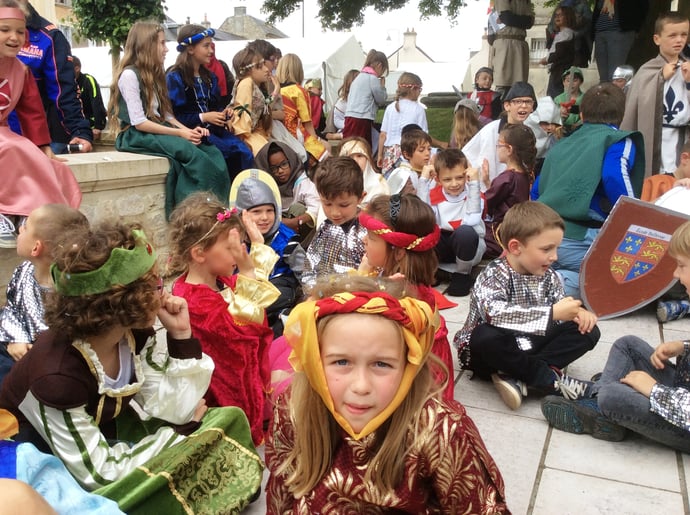
Medieval parade in Bayeux of the school of our son, Swann
Bayeux, headquarters of Normandy American Heroes
On the 14th of June 1944, General de Gaulle went to France aboard the frigate “La Combattante”. After coming ashore on the coast of Normandy (Courseulles sur Mer - Juno beach), he headed towards Bayeux, a town which was liberated on the 7th June by the British troops, totally preserved of bombardments, a miracle!
His famous speech, on what is known today as “place Charles de Gaulle just behind the Cathedral”, will give no choice to the Allies but to recognize the sovereignty of France thru General de Gaulle:
“We are all moved to be together again in one of the first liberated towns of metropolitan France, but this is not time to be talking of our emotions. What the country expects of you, behind the front, is that you carry on the fight today, as you have never stopped doing so since the start of this war and since June 1940. Our cry, now, as always, is a battle cry, because the path into battle is also the path to freedom and the path of honor.
It is the voice of motherland. We will continue to wage this war with our ground, sea and air forces as we are doing today in Italy, where our soldiers have covered themselves in glory, as they will do tomorrow in metropolitan France. Our Empire, all gathered around us, is providing huge assistance. We will fight for France with passion, but also with reason.
You who have been under the enemy’s heel and have belonged to Resistance group, you know what this war is like. It is a particularly difficult war, this underground ward, this war without weapons. I promise you that we will continue the war until the sovereignty of every inch of French territory is re-established. No-one will stop us doing this.
We will combat alongside the Allies, with the Allies, as an Ally. And the victory that we will achieve will be a victory for freedom and a victory for France.
I am going to ask you to sing our national anthem with me, the Marseillaise.”
General de Gaulle, after his unforeseen coup, sailed back to England the following day!
Bayeux, old capital of the Bessin, was therefore the first city of France liberated on June 7th 1944 and capital of France until Paris was liberated.
Fortunately it suffered no serious damage. Its cathedral continues to watch over the city and the tapestry of Queen Mathilde, a document of unique value, enchants an average of 400,000 visitors per year!
Its old houses, nicely restored, its pedestrian area with boutiques bring an added attraction to the visit of the city.
You will need at least two days to visit the incredible Norman Gothic Cathedral of Notre Dame de Bayeux, the tapestry of Bayeux, the Commonwealth cemetery, the museum of the Battle of Normandy, the History and Art museum of Baron Gérard and finally the memorial of the Reporters.
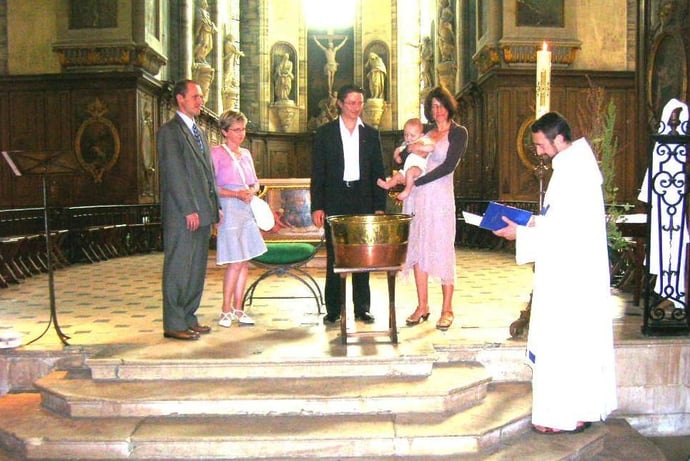
Baptism of our son Swann, the traditional way, at the Abbey of Mondaye
Abbey of Saint-Martin-de-Mondaye
I strongly recommend you to attend the beautiful mass service at the Abbey of Mondaye, built in 1215. We baptized my son Swann there, traditionally immersed in a cauldron…memorable and moving moment in my life as a father. It’s also the perfect place to experience a spiritual retreat!
In the Middle Ages the hill where the Abbey is situated was called “Ae”. In the language “d’Oil” (the “Langue d’Oc” and the” Langue d’Oil” are the two principal groups of dialects spoken in medieval France...), it meant water. The sources of the “Mont d'Aë” fed the region: an aqueduct led its waters to the Roman baths of Bayeux, of which there were found in 1870 some vestiges.
In the middle of the XII century, a priest named Turstin decided to live as a hermit on this hill called “Mondée”. As it was common then, he is joined by some disciples. Wishing to establish an abbey, the bishop of the place, Jourdain du Hommet turned to the Abbey of the “Lucerne d’Outre-Mer”, in the diocese of Avranches. The abbot Angost accepted his request and sent out a small colony of monks, around 1202, on the “Mont d'Aë” that the Latin of the charters of the time quickly transformed into "Mons Dei", the Mountain of God.
The name chosen is no doubt well founded, thanks to the generosity of the Lord of Juaye and Bishop Jourdain, the first community, poor and fervent, transforms the Mountain of God into a place of prayer and charity.
The medieval Premonstratensians are known for their charisma of hospitality - to the point that Louis XI, establishing a hospital in Paris, does not want to hear of other hospitable than the charitable Premonstratensians! Mondaye (this is the modern spelling of the place) is no exception to this rule. A leprosarium - of which there are still traces today - will work for a long time, maintained by the brothers.
The first known abbot was Roger de Juaye, who ruled the abbey until 1215. It was he who presided over the insertion of the community into the family of regular canons of Premonstratensians, with a life obeying the rule of Saint Augustine, the liturgy and the customs used in the Order.
In accordance with Saint Norbert's wish, the Premonstratensians of Mondaye have a life centered on the liturgy - the canonical service, celebrated day and night - but gradually occupy the "pastoral land" around the monastery.
Today in Europe, the Mondaye Abbey has some special bonds with two Belgian abbeys, the Leffe Abbey and the Grimbergen Abbey known for their beer!
To conclude, only two abbeys survived the French Revolution: the abbey of Frigolet near Avignon, and the abbey of Mondaye in Normandy.
Port-en-Bessin
On the coastline, 10 minutes drive from Bayeux is the beautiful harbor of Port-en-Bessin used after D-Day as an oil terminal, the famous PLUTO line.
The allied plan had revolved around the speedy capture of Port-en-Bessin so as to dispose of port facilities enabling the troops to be supplied with fuel, more or less in the middle of the assault British/American sector, until such time as the Mulberry could be built at Arromanches/Asnelles-sur-Mer (Gold beach) and Vierville-sur-Mer/Saint-Laurent-sur-Mer/Colleville-sur-Mer (Omaha beach), the last totally devastated by a ferocious storm two weeks after the landing!
The capture of this fishing port, renowned for its Scallops even today, had been entrusted to the 47th Royal Marine Commando Corps. After a landing rendered extremely difficult due to floating mines near the hamlet Le Hamel (Gold beach), the crack British troops moved on inland, covering approximately 20 miles; faced with ambushes, fierce German resistance and the 100 pounds of equipment that each man was carrying on his back, they reached the Mont Cavalier, south of Port-en-Bessin. “No man had done more, and few had done so much”.
Following aerial and naval bombardment of the German strongpoints, the harbor fell under the control of the Allies during the night of the 7th to the 8th of June 1944.
With this conquest, Gold beach was finally linked up to Omaha beach, the Allies now controlling one single stretch of coastline about 40 miles long, from the bottom of the Bay of the Seine.
Shortly afterwards, Port-en-Bessin only slightly damaged, received the first convoys of supplies for the front lines.
Along dykes, the engineers set up an oil terminal for tankers of average tonnage coming from British ports. Thanks to a pipeline and a pumping station, the fuel was stored in huge tanks a little further inland, on the high ground of the Mont Cauvin near the village of Etréham (D206). From there, pipelines brought the precious fuel up to the front before being replaced by the “major system”, the kingpin of which was PLUTO, code name of the pipeline laid on the bottom of the English channel between the Isle of Wight and Cherbourg. The Red Ball Express then would do the rest to support the troops moving toward Germany…
The port is located in a hollow of marl cliffs. “Port” so named commonly in the Bessin, is a lively haven whose smallness makes it even more picturesque. You will enjoy its local open air market every Sunday morning on the harbor and the famous “criée” (fish auction).
Port-en-Bessin, surprisingly, when you see the size of the harbor, is the most active fishing port of France! Take the time to walk thru this beautiful, colorful village, discover the tower of Vauban overlooking the harbor, climb the cliffs to visualize some of the German strongpoint.
Last but not least, if you love playing golf, do not hesitate to try out the 18 hole of Port-en-Bessin situated on a German strongpoint!
Castle of Balleroy
West of Bayeux (20 minutes drive), near the forest of Cerisy is the beautiful castle of Balleroy.
Built in 1631 by the celebrated architect François Mansart (1598-1666) at the request of Jean de Choisy, the Château de Balleroy and its surrounding buildings are one of the first urban plans that inspired other châteaux, including Versailles! All the buildings were built from scratch. The château itself has retained almost all of its original features and it is because of this that it witnessed the major innovations of the 17th Century.
In 1970, Malcolm S. Forbes, owner of a major U.S. newspaper group bought the château which was then fully restored and refurbished. Today, his four sons and his daughter continue his work.
Visiting the château will give you the opportunity to relive the incredible history of air balloons since their inception up to the present day. Between 1970 and 1999, the château de Balleroy organized a large meeting of hot air balloons. Why? Simple, the owner, Malcolm Forbes, billionaire and tycoon of the press, was a lover of balloons. Every year until his death in 1990 he brought back ideas of new hot air balloons from his travels, such as the Fabergé egg-shaped hot-air balloon, and the Château de Balleroy!
Let’s not forget that during WWI the air balloons were used to observe the enemy while during WWII they were used as barrage balloon. In 1938 the British Balloon Command was established to protect cities and key targets such as industrial areas, ports and harbors. Balloons were intended to defend against dive bombers flying at heights up to 5,000 feet (1,500 m), forcing them to fly higher and into the range of concentrated anti-aircraft fire - anti-aircraft guns could not traverse fast enough to attack aircraft flying at low altitude and high speed. By the middle of 1940 there were 1,400 balloons, a third of them over the London area.
On D-Day the Armada transporting approximately 135,000 soldiers will also use barrage balloons…
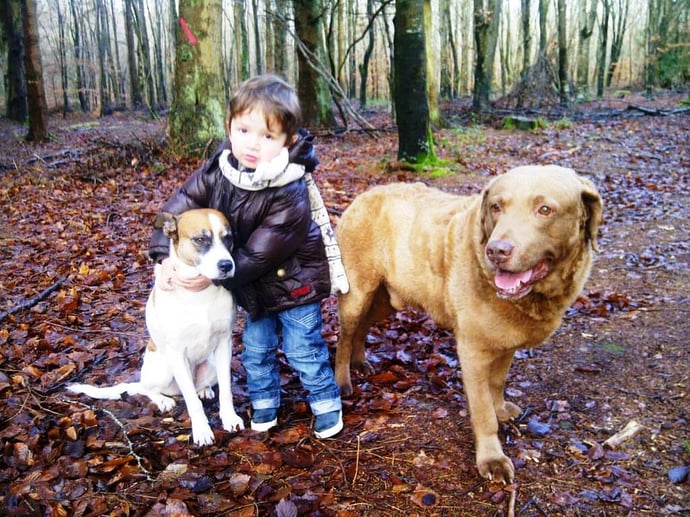
Cerisy Forest with Swann and my dogs Barbie and Vlad de la Lune de Sang
Cerisy Forest
You can now take the time to walk thru the beautiful forest of Cerisy where you will have the opportunity, if you are lucky and discreet, to see deer like stags (still haven’t seen one yet!), roe as well as boars, badgers, foxes, squirrels…
The origins of the forest domain of Cerisy can be traced all the way back to William the Conqueror. The 250 hectare of the “Bois l’Abbé” was given by William to the monks of the magnificent abbey in 1042, and remained the abbey’s property until after the French Revolution. It became the property of the State in 1845.
The “Bois des Biards” also belonged to the Dukes of Normandy. In 1204 when Normandy was attached to the kingdom of France, this wood became part of the royal territories and therefore State property in 1791. A royal ordinance of 1845 combined these two woods and required them to be used for beech tree plantations.
Walking toward Cerisy-la-Forêt village one can discover a royal bollard of the XVIII century engraved with a fleur-de-lys that delimited the royal domain.
Despite the galloping industrialization of Normandy as the number of ironworks rose, Cerisy’s held on to its boundaries and consequently remains the best-preserved forest in lower Normandy.
Most of its trees are still beeches and oaks, with just a few areas dedicated to Scotch firs.
Regretfully the bombing of 1944 caused severe damage to the forest. Thus, all the stands of trees located around the present crossroads “L’Embranchement” (cross road Bayeux – Saint Lô and Le Mollay Litry – Balleroy) only date back to the 1960s.
Therefore you will be able to notice the presence of numerous impacts of bombs throughout the eastern part of the massif. Weapons caches are also visible if you take the time to observe your environment!
Needless to say it’s a pleasant forest to relax both for amateurs, nature lovers and ornithologists.
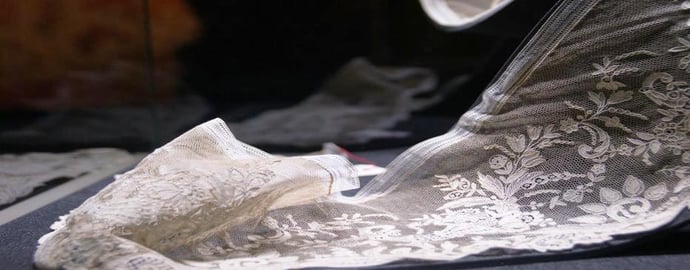
Alençon lace
Alençon
The notoriety of this small town which was once the city of the Dukes of Normandy rests on the extreme delicacy of its lace. Made a royal manufacture under Louis XIV, Alençon has preserved all the richness of its past.
Around 1650, Madame de la Perrière perfected the point of Venice, very popular in all European courts, and taught it to young Alençonnaises. Lace making production is developed: 8,000 people work at this point of needle. However, the fashion of lace incites men and women to extravagant expenses, often outside French territory. Thus Colbert decided in 1665 to establish a royal factory in Alençon, responsible for the production of the point of France, prohibiting the importation of foreign lace.
Lace makers develop their own style through the invention of a particular technique, the network: light patterns associated in tight symmetrical designs on a very light background. This is the origin of the point of Alençon which, at the end of the XVII century, ends up being appreciated. Each lace maker was specialized in a single phase of the point and was unaware of the work of others. It took more than sixteen hours to make 3 cm and nearly ten years for a complete creation!
In the nineteenth century this secular tradition of lace with a needle is named Queen of the laces.
The museum is housed in the former Jesuit college (XVII century) and brings together collections of laces and paintings from the 15th to the 19th century. It will allow you to travel in time and discover the main lace centers of Italy (Venice, Milan), Flanders (Brussels) and France (Chantilly, Bayeux).
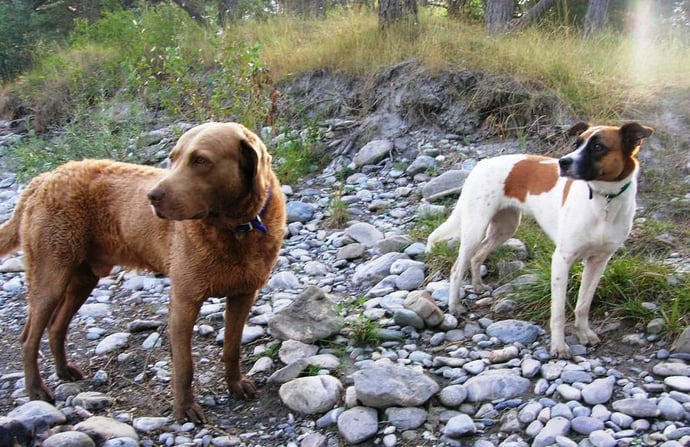
Vlad de la Lune de Sang and Barbie ready to chase some deers in the forest of Bagnoles-de-l'Orne!
Bagnoles-de-l’Orne
Balneolum, the Latin root of Bagnoles, means bathing, so everything is said! Here the water has been treating for a long time by the bath, the basis of the treatment.
The town grew thanks to the arrival of the railway in 1869. Holidaymakers or bathers came to exile themselves momentarily in this small town which found an important development until the First World War.
A horse treatment! Not being able to make up his mind to put away his faithful steed, sick with rheumatism, Hugh de Tessé decides one day to abandon him in the forest of the Andaines. Shortly afterwards, he was surprised to see his horse come back to the stable, dashing and vigorous, the eye sharp and a shiny coat. He notices that the animal regularly immerses itself in the water of a lukewarm source. He follows his example, bathes and finds, in turn, strength and youth…
Another story tends to prove the efficacy of the cure: that of the Capuchin monk who, cured of his pains, crosses in one leap, the four meters separating the two rocky needles overhanging the source. The place, which we recommend you to visit, remains named the Capuchin monk jump in memory of his feat.
Named the “secular Lourdes”, thanks to the many miracles produced by the water source, Bagnoles-de-l’Orne water is renowned for its expertise in treating rheumatology, using exclusively the Great Source. The water flows (50,000 liters per hour) with a constant temperature of 25.8 degrees Celsius. It is the only hot spring in Normandy, the least mineralized in France. It relieves and/or cure the disorders of the venous circulation, in particular the sequelae of the phlebitis and, preventively, the varicose veins. You will also be able to find happy solutions for fracture sequelae, trauma sequelae, and malfunction of the endocrine glands...
While visiting or staying in Bagnoles-de-l’Orne I strongly recommend you walk in the forest of the Andaines to see the Saint-Antoine chapel and the Gorges de Villiers. Take a picnic with you as it’s a great place to resource yourself, surrounded by a beautiful environment.
My favorite place while living in Putanges-Pont-Ecrepin to walk my Chesapeake Bay retriever, Vlad de la Lune de Sang.

Billy Bye Mussel soup
Barfleur
This small fishing port with granite houses and docks loaded with lobster traps or mussel pallets is considered one of the most beautiful villages in France. The mussels of Barfleur are reputed to be the best of France, I confirm!
It turns out to be a very welcoming seaside resort, where after having spent time on the beautiful beach or taken a promenade in the country you will be more than impatient to savor in the evening the “blondes, name given to the mussels of Barfleur!
After the invasion of England by William the Conqueror, his inheritance was soon gathered in the hands of his third son: Henri Beauclerc. The latter took the sea at Barfleur to England. His son and one of his daughters embarked on the ship “Blanche Nef”. After an unfortunate distribution of wine to the crew, the boat crashed on the reefs of Gatteville, and the two children of the king perished drowned! Only one daughter, Mathilde, survived. She married the descendant of the Count of Anjou. Their sons, Henry Plantagenet, later became Henry II, King of England.
It was also from Barfleur that Richard the Lion-heart embarked in 1194 to be crowned King of England.
After the Dday landing it is said that the famous Billy Bye mussel soup was created or rather baptized as such during a banquet presided over by an officer called Billy, who was told after the dinner "bye bye Billy!" Rumors nowadays are still well anchored…
We owe the key to the mystery of the Billy Bye Mussel soup to Mrs. Mapie de Toulouse-Lautrec, a gastronomic journalist, a fine cook and creator of Elle's cookbooks. In her book, "Maxim's: Secrets and recipes from the world's most famous restaurant”, published in the United States in 1962, she recounts: "It was Louis Barthe, the former chef at Maxim's, who told me the story of Billy Bye Soup. In 1925, he worked in the kitchen of" Chez Ciro ", a restaurant renowned in Deauville. Here were served Mussels usually eaten with fingers (most people still do so!), by using the double shell of the mollusk as a mussel. One day, a loyal client, Mr. William Brand, decided to invite some American friends. Mr. Brand wanted to spare his guests this tedious job, and asked the chef to have the juice served without the shells. It was such a success that during the days that followed his guests returned separately to "Chez Ciro" to order the "Billy Brand Soup." By discretion, the menu was set as "Billy B Soup." Thus was born the classic "Soup Billy By" a soup so famous, that you can still savor it hot or cold at the renowned "Chez Maxim's" restaurant in Paris!
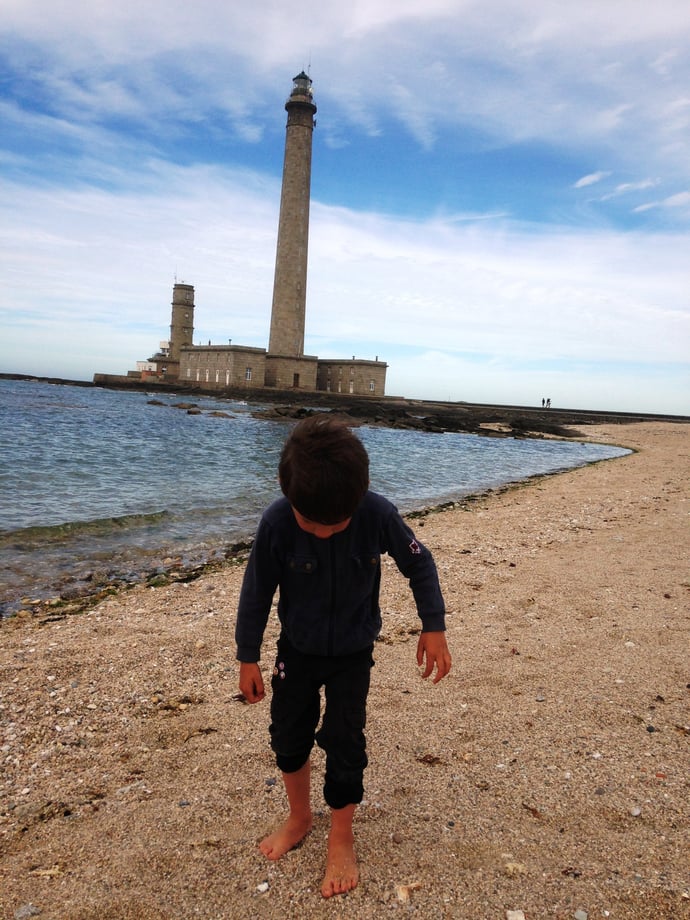
Barfleur lighthouse with my son Swann
Pointe de Barfleur
With its 75 meters, it is one of the highest lighthouses in France. Built from 1829 to 1835 its light beam can be seen 56 kilometers away. He still guides today the ships in their approach to the port of Le Havre! It has 365 steps (365 days of the year), 52 windows (52 weeks) and 12 floors (12 months). From the summit, if you are brave to climb up to the top, you can admire the panorama that extends on the east coast of the Cotentin. You will be able to see the famous islands of Saint-Marcouf, the bay of the Veys, and if you are lucky to have clear weather, the cliffs of Grandcamp Maisy and La Pointe du Hoc where the 2nd Rangers battalion landed on D-day.
The sinking of the vessel Blanche Nef (1120) took place on the rock of Quillebeuf, 800 meters from the lighthouse. 300 of the most brilliant representatives of the Anglo-Norman nobility perished with the heirs of William the Conqueror.
Port Racine
Renowned as the smallest port in France, Port Racine is located in Saint Germain des Vaux in The Hague (north-western end of the Manche peninsula).
Its surface is only 800 m². François Médard Racine, one of the last corsairs during the Napoleon's era gave his name to the port
Once a refuge for this privateer and a privileged place for exchanges with the Channel Islands, it now houses modest boats for fishermen and boaters.
It is a haven of peace where fishermen, holidaymakers, locals and hikers meet for a well deserved break.
Chausey Islands
Just imagine: 17km from the Monaco of Normandy (Granville), a maze of channels, sandy plains and granite lace on the horizon of the strongest tides in Europe. You will find there one of the most extraordinary sites that Normandy can offer you: the Chausey islands, archipelago of several square kilometers grouping about fifty islands or islets and hundreds of reefs. To appreciate all the beauty of this chaos of granite which is transformed by the rhythm of the sun and tides, we strongly recommend you to stay there one night.
The archipelago owes its name to the presence of granite: “Calais” in Latin became "Causey", "Chauzyé" then Chausey.
The quarries, exploited for a long time, produced the beautiful granite of Chausey used at the Mont Saint Michel, in the manors of the Cotentin, some sidewalks of the Parisian boulevards and even the quays of Saint Malo!
Luckily the gulf stream passes there, it’s not like the Caribbean, nevertheless you can go out swimming, the water is crystal clear and the colors magnificent!
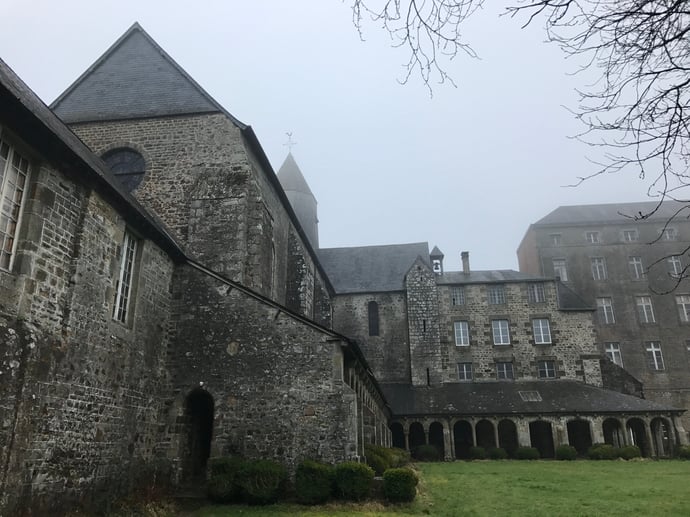
Abbey "blanche" of Mortain
Mortain
Some cities are more privileged than others by nature: Mortain is one of them. Built on a hillside, in a narrow valley, Mortain sees the waters of the Cance and Cançon run down a large and small waterfall! A spectacle as grand as it is wild. Despite the destructions of 1944, the city has a beautiful heritage, including the dazzling Abbaye Blanche and the collegiate church of Saint-Evroult.
From the famous Hill 314 you have an incredible view of the Mont Saint Michel during a clear day, well worth the walk in the beautiful forest where elements of the 30th Infantry Division fought for 6 long days stopping the counterattack of the Nazis…the turning point for the upcoming unconditional surrender of Germany, the 8th of May 1945.
This is a great area for beautiful walks in the country and nearby forest…
La Roche d’Oëtre
In the heart of a magnificent site, dominating the gorges of the river Rouvre, the Oëtre rock offers the most beautiful mountainous spectacle of what is known as the “Suisse Normande”, the oldest mountain range of France.
Ideal stop for the nature lovers, bring a picnic with you and enjoy the scenery.
A few years ago they have created in the forest overlooking the valley a great tree climbing path for all levels and accessible as of 3 years old! This is where my son Swann discovered the joy of climbing in the trees…really worth spending half a day there
Not far from there, is the beautiful town Putanges-Pont-Ecrepin where I used to live, perfect stopover to go on a river / lake cruise to the Rabodanges dam.
Last but not least, one of my favorite spot was the Mesnil Jean hamlet by the Orne river; you can walk for hours in perfect harmony with the nature…
Viaduct de la Souleuvre
The old viaduct built in 1869 on the plans of Gustave Eiffel for the railway Vire-Caen was ruined and abandoned. Since 1990, the Viaduct de la Souleuvre offers sensational activities for young and old: sledding on rails, zip lines, giant swings, barefoot garden, pendulum jumps and bungee jumps. A footbridge of 140 meters and a platform have been laid out to be able to jump to 61 meters above the river, the Souleuvre! Sensation guaranteed… This protected natural site is setup so you could spend the day there with your family.
You will find a Picnic area, a bar-restaurant, the possibility to organize a barbecue, games for children, hiking, mountain biking, cycling… The parking is free on both sides of the valley.
The less adventurous will enjoy the spectacle and screaming of the courageous bungee jumpers! You can then go off for a pleasant walk in the woods along the river
The enchanted village of Bellefontaine
One of the favorite places of my son, since then he has discovered another great park near Rouen, the Parc du Bocasse. Nevertheless I strongly recommend it if you have young children travelling with you as they are plenty of games and entertainment for the whole family.
Tyrolean for young and old (2 years old minimum), tree climbing, discovery of farm animals, pony rides...
Young and old, do not wait any longer to immerse yourself in the world of childhood and imagination. Take the bucolic trails and stroll in a marvelous setting where elves and fairy tales remain.
If you are looking for some thrill with the family walk on the suspension bridge a few meters high, 250 meters long! Then if you are courageous, take the big jump on the maxi zip line.
You can cross the pond in the pirate’s barge or discover the cave where ghosts are hiding in the darkness.
As you have guessed there's no age for fun! With your family, enter the fairytale village of Bellefontaine and enjoy a great day there.
If your children are a bit older, then I would go to the Park de la Bocasse, much better than Festiland near Caen!!!!
Parc du Bocasse
The Parc du Bocasse is situated in the heart of Normandy, 25 km from the city of Rouen. You will discover a park designed for the whole

















